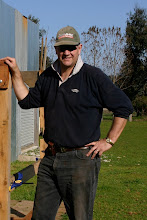Last week I got 60 m3 of poultry manure and rice hulls being removed from a shed near Riddells Creek. That has allowed me to 'shandy' this high nitrogen, but natural fertiliser with the approximately 60 m3 of compost I made this year - for spreading onto my paddocks.
The process goes like this: put a front end loader bucket of chicken manure in my H&S manure spreader - as shown in photo 1.
You can see part of one of 2 huge piles of chicken manure to the right.
 Then: add a bucket load of my compost - as in photo 2.
Then: add a bucket load of my compost - as in photo 2.I started out with a similarly huge pile of compost. It's mainly made from the waste hay and cow manure we clean out of the Feed Yard. But everything else I can get that is compostable also goes in.
To the left of photo 1 is the stack of urban green waste. We're in the process of working out whether the effort required to remove non-compostable garbage is worthwhile.
Then: drive to the paddock where you want to spread the material. Then engage the ground drive - as you can see me doing in photo 3.
The ground drive works from the wheels of the manure spreader. It makes the beater you can see to the right spin around - and, at the same time, an apron in the bottom of the spreader drags the material back onto the beater blades.
 I'm pulling the spreader with a Polaris Ranger with a 700 cc engine - which is about the minimum it needs. Using the Ranger rather than the tractor is quicker for me - and reduces the weight of the traffic on the pasture.
I'm pulling the spreader with a Polaris Ranger with a 700 cc engine - which is about the minimum it needs. Using the Ranger rather than the tractor is quicker for me - and reduces the weight of the traffic on the pasture.The paddock I'm spreading onto was cell grazed about 3 weeks ago. Cell grazing is a process where the cows get a measured amount of pasture each day - before moving onto a fresh piece of pasture the following day.
It results in much better utilisation of pasture - and faster re-growth. When done well it can result in 2, 3 or 4 times the pasture production of the traditional set stocking system.
 It is made possible by single wire electric fencing. I have this paddock divided into 4 strips that allow the cattle to get back to the trough - and to some shade.
It is made possible by single wire electric fencing. I have this paddock divided into 4 strips that allow the cattle to get back to the trough - and to some shade. If I was following absolute best practise, I would have a backing wire that keeps them off yesterday's area - and provide some sort of movable water system. I'm still thinking about how to do this.
The final photo shows the spreader spreading. I simply put it in low gear and drive along at walking speed until, after 120 or 130 metres it starts throwing the last of the load up into the air - and, if the wind is blowing in the wrong direction, back onto me.
The spreader has a capacity of 80 cubic feet. This tells you where it comes from ... the only place that doesn't use the metric system. In any case, that is 2.25 cubic metres - and I estimate that it covers around 500 square metres. So, following this, I will put out 50 cubic metres per hectare.
It's going to take me a while to cover the farm, but that is the aim.
F





No comments:
Post a Comment